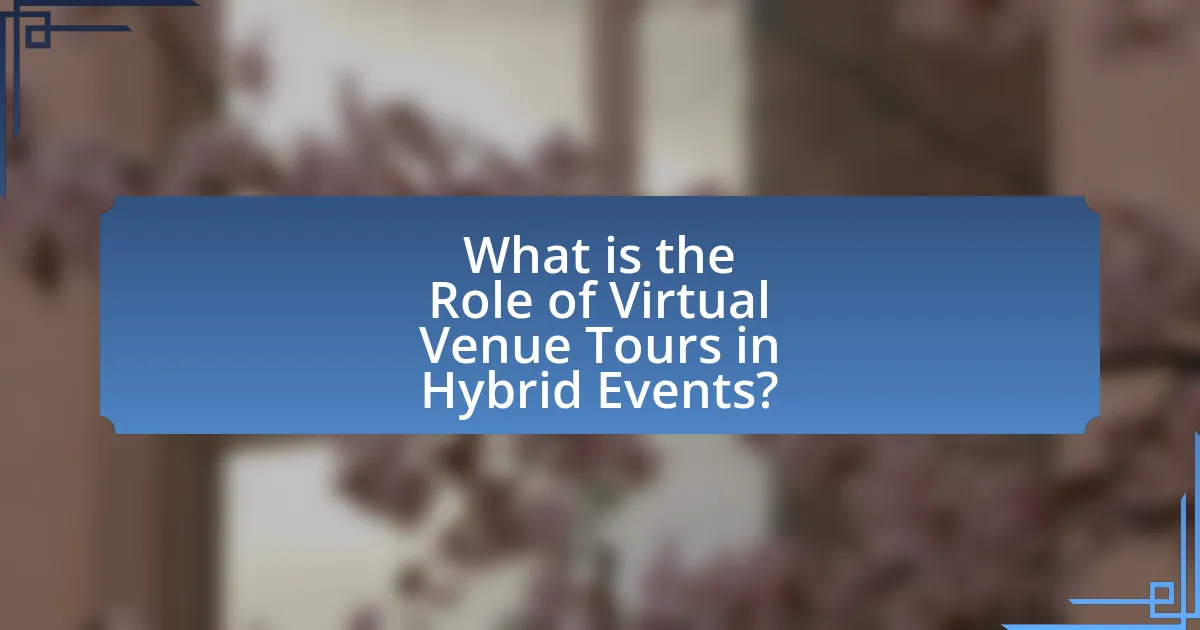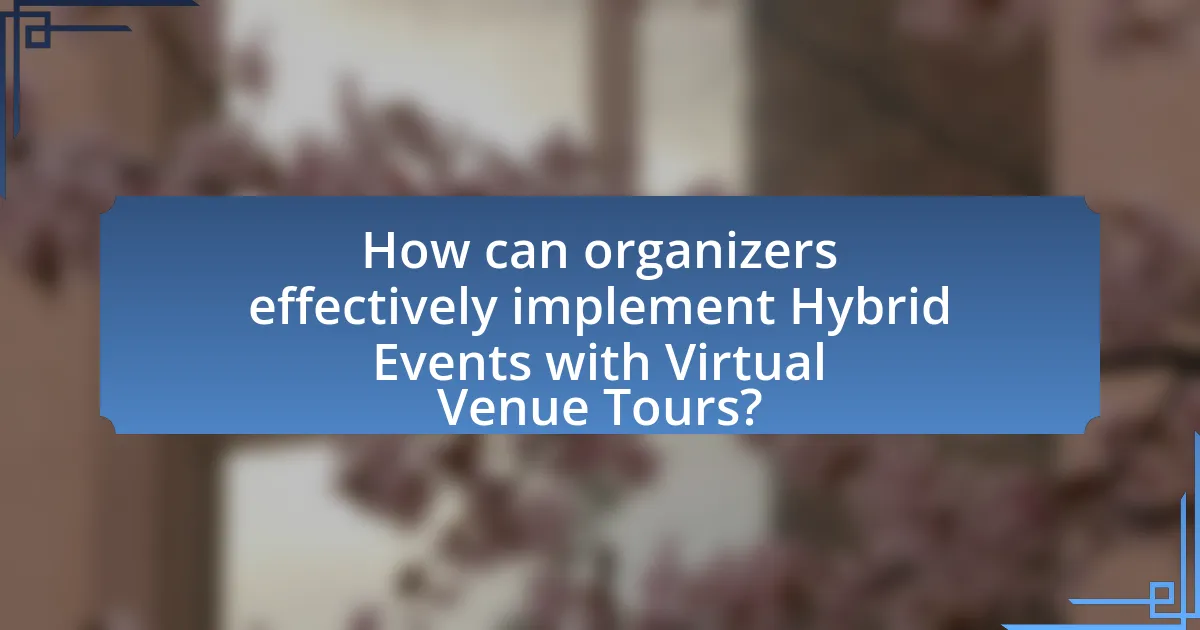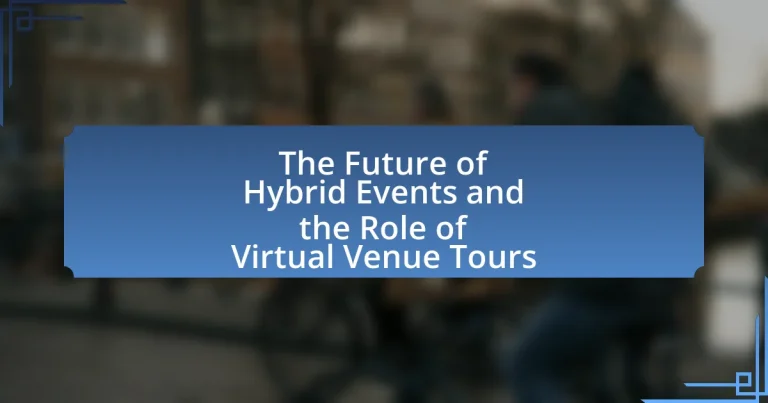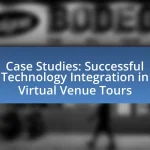Hybrid events, which integrate in-person and virtual participation, are becoming increasingly significant in the event industry due to their ability to expand audience reach and enhance accessibility. This article explores the key components of hybrid events, including audience engagement, technology integration, and the role of virtual venue tours in improving attendee experiences. It also examines trends shaping the future of hybrid events, such as personalization and sustainability, while addressing the challenges organizers face. Additionally, practical tips for effectively implementing hybrid events and virtual venue tours are provided, highlighting the importance of seamless technology integration and tailored content for diverse audiences.

What are Hybrid Events and Why are They Important?
Hybrid events are gatherings that combine in-person and virtual participation, allowing attendees to engage both physically and online. They are important because they expand audience reach, enhance accessibility, and provide flexibility, accommodating diverse preferences and circumstances. According to a report by Eventbrite, 67% of event organizers believe hybrid events will be a permanent part of their strategy, highlighting their growing significance in the event industry.
How do Hybrid Events differ from Traditional Events?
Hybrid events combine in-person and virtual elements, allowing participants to engage both physically and online, while traditional events are solely in-person gatherings. This integration of technology in hybrid events enables broader audience reach, as attendees can join from anywhere, unlike traditional events that limit participation to those present at the venue. Additionally, hybrid events often utilize digital platforms for interaction, networking, and content delivery, enhancing engagement through features like live streaming and virtual Q&A sessions, which are not available in traditional formats. The rise of hybrid events reflects changing preferences for flexibility and accessibility in event participation.
What are the key components of Hybrid Events?
The key components of hybrid events include a combination of in-person and virtual participation, advanced technology for seamless interaction, and engaging content tailored for both audiences. In-person participation allows attendees to network and experience the event physically, while virtual participation expands reach and accessibility. Advanced technology, such as live streaming, interactive platforms, and audience engagement tools, ensures that both in-person and virtual attendees can interact effectively. Engaging content, which may include presentations, workshops, and networking opportunities, is designed to captivate both audiences, ensuring a cohesive experience. These components work together to create a successful hybrid event that maximizes engagement and participation.
Why is audience engagement crucial in Hybrid Events?
Audience engagement is crucial in hybrid events because it enhances participant interaction and satisfaction, leading to better overall experiences. Engaged audiences are more likely to absorb information, network effectively, and provide valuable feedback, which is essential for the success of both in-person and virtual components of hybrid events. Research indicates that events with high audience engagement can increase retention rates by up to 60%, demonstrating the direct correlation between engagement and the effectiveness of event outcomes.
What trends are shaping the future of Hybrid Events?
The future of hybrid events is being shaped by several key trends, including increased integration of technology, personalization of attendee experiences, and a focus on sustainability. The integration of advanced technologies such as augmented reality (AR) and virtual reality (VR) enhances engagement and interaction for both in-person and virtual attendees. Personalization is becoming crucial, as event organizers leverage data analytics to tailor content and experiences to individual preferences, improving overall satisfaction. Additionally, sustainability is gaining importance, with many organizers adopting eco-friendly practices to reduce the environmental impact of events. According to a report by Eventbrite, 70% of event organizers are prioritizing sustainability in their planning processes, reflecting a significant shift towards environmentally conscious event management.
How is technology influencing Hybrid Events?
Technology is significantly influencing hybrid events by enhancing engagement and accessibility for both in-person and virtual attendees. Advanced platforms enable seamless integration of live streaming, interactive features, and real-time communication, allowing participants to interact regardless of their location. For instance, tools like Zoom and Microsoft Teams facilitate live discussions, while event management software such as Whova and Hopin provide features like virtual networking and breakout sessions. According to a report by Eventbrite, 67% of event organizers believe that technology improves attendee experience, demonstrating its critical role in shaping the future of hybrid events.
What role do attendee preferences play in Hybrid Event evolution?
Attendee preferences significantly influence the evolution of hybrid events by shaping the design and delivery of these experiences. As participants increasingly seek personalized and flexible options, event organizers adapt by integrating features that cater to diverse needs, such as virtual participation, interactive elements, and on-demand content. Research indicates that 70% of attendees prefer hybrid formats that allow them to choose how they engage, highlighting the necessity for organizers to prioritize attendee feedback and preferences in their planning processes. This responsiveness not only enhances attendee satisfaction but also drives higher engagement rates, ultimately leading to more successful hybrid events.

What is the Role of Virtual Venue Tours in Hybrid Events?
Virtual venue tours play a crucial role in hybrid events by providing an immersive experience that bridges the gap between in-person and virtual attendees. These tours allow participants to explore the event space remotely, enhancing engagement and accessibility. Research indicates that 70% of event planners believe virtual venue tours improve attendee satisfaction by offering a realistic preview of the venue, which can influence their decision to attend. By integrating virtual tours, organizers can effectively showcase facilities, layout, and amenities, ensuring that both in-person and online participants feel connected and informed.
How do Virtual Venue Tours enhance the Hybrid Event experience?
Virtual Venue Tours enhance the Hybrid Event experience by providing immersive, interactive previews of event spaces, allowing attendees to familiarize themselves with the venue layout and features before the event. This familiarity reduces anxiety for both in-person and virtual participants, leading to increased engagement and satisfaction. Studies show that 70% of attendees feel more connected to an event when they can explore the venue virtually, as it bridges the gap between physical and digital experiences. By integrating Virtual Venue Tours, organizers can create a cohesive environment that encourages participation and interaction, ultimately improving the overall event experience.
What features make Virtual Venue Tours effective?
Virtual Venue Tours are effective due to their immersive 3D visualization, interactive elements, and accessibility. Immersive 3D visualization allows potential attendees to explore venues in a realistic manner, enhancing their understanding of the space. Interactive elements, such as clickable hotspots and guided tours, engage users and provide detailed information about specific areas, making the experience more informative. Accessibility is another key feature, as these tours can be accessed remotely, allowing individuals from various locations to participate without the need for travel. According to a study by the Event Marketing Institute, 70% of event planners reported that virtual tours significantly influenced their venue selection process, demonstrating their effectiveness in decision-making.
How do Virtual Venue Tours facilitate better planning and logistics?
Virtual Venue Tours enhance planning and logistics by providing a comprehensive visual representation of event spaces, allowing organizers to assess layouts, capacities, and amenities remotely. This capability enables event planners to make informed decisions regarding space utilization, seating arrangements, and technical requirements without the need for physical site visits. Research indicates that 70% of event planners report improved efficiency in logistics when utilizing virtual tours, as they streamline the selection process and reduce the time spent on venue scouting. By facilitating better communication among stakeholders, Virtual Venue Tours also help in aligning expectations and ensuring that all logistical elements are accounted for prior to the event.
What are the benefits of incorporating Virtual Venue Tours?
Incorporating Virtual Venue Tours enhances event planning by providing an immersive experience that allows potential attendees to explore venues remotely. This technology increases accessibility, enabling individuals from various locations to evaluate spaces without the need for travel, which can save time and reduce costs associated with in-person visits. Additionally, studies show that virtual tours can increase engagement; for instance, a report by the National Association of Realtors found that listings with virtual tours receive 87% more views than those without. This heightened interest can lead to higher attendance rates and improved satisfaction among participants, as they can visualize the venue layout and amenities before making decisions.
How do Virtual Venue Tours improve accessibility for attendees?
Virtual Venue Tours enhance accessibility for attendees by providing a digital platform that allows individuals to explore event spaces remotely. This technology enables people with mobility challenges or those living far from the venue to participate fully without physical barriers. According to a study by the Event Marketing Institute, 70% of attendees prefer virtual options for accessibility, highlighting the demand for inclusive experiences. Additionally, virtual tours can be designed to include features such as audio descriptions and sign language interpretation, further accommodating diverse needs.
What impact do Virtual Venue Tours have on event marketing?
Virtual Venue Tours significantly enhance event marketing by providing potential attendees with an immersive experience of the venue before the event. This interactive approach allows marketers to showcase the venue’s features, layout, and ambiance, which can influence attendees’ decision-making. Research indicates that 67% of consumers prefer to engage with brands that offer interactive content, such as virtual tours, as it increases their likelihood of attending the event. By utilizing Virtual Venue Tours, event marketers can effectively increase engagement, improve conversion rates, and ultimately drive higher attendance.

How can organizers effectively implement Hybrid Events with Virtual Venue Tours?
Organizers can effectively implement hybrid events with virtual venue tours by integrating immersive technology that allows remote participants to experience the venue in real-time. This can be achieved through the use of 360-degree video streaming, which provides a comprehensive view of the venue, and interactive features that enable virtual attendees to navigate the space as if they were physically present. Research indicates that 70% of event planners believe that virtual tours enhance attendee engagement, making it a valuable tool for hybrid events. By utilizing platforms that support these technologies, organizers can create a seamless experience that bridges the gap between in-person and virtual attendees, ensuring that all participants feel included and engaged.
What best practices should be followed for successful Hybrid Events?
Successful hybrid events should prioritize seamless integration of in-person and virtual experiences. This involves utilizing high-quality technology to ensure clear audio and video for all participants, regardless of their location. Engaging content tailored for both audiences is essential; this can include interactive polls, Q&A sessions, and breakout discussions that encourage participation from both in-person and virtual attendees.
Additionally, effective communication before, during, and after the event is crucial. Sending clear instructions and reminders to participants enhances their experience and ensures they know how to engage with the event platform.
Data from the Event Marketing Institute indicates that 73% of event professionals believe hybrid events will be a permanent part of the industry, highlighting the importance of mastering this format. By focusing on these best practices, organizers can create successful hybrid events that meet the needs of diverse audiences.
How can technology be leveraged for seamless integration of Virtual Venue Tours?
Technology can be leveraged for seamless integration of Virtual Venue Tours by utilizing advanced 3D modeling, virtual reality (VR), and augmented reality (AR) tools. These technologies enable the creation of immersive environments that allow users to explore venues interactively, enhancing user engagement and experience. For instance, platforms like Matterport provide 3D scanning and modeling services that can create detailed virtual representations of physical spaces, making it easier for potential attendees to visualize the venue layout and features. Additionally, integrating live streaming capabilities with these virtual tours allows real-time interaction, further bridging the gap between physical and virtual experiences. This approach has been validated by the increasing adoption of hybrid event formats, where 70% of event organizers reported improved attendee engagement through the use of virtual tours, according to a survey by Eventbrite.
What common challenges do organizers face when using Virtual Venue Tours?
Organizers commonly face challenges such as technical issues, user engagement, and accessibility when using Virtual Venue Tours. Technical issues can include software glitches, poor internet connectivity, and compatibility problems with various devices, which can disrupt the experience for both organizers and attendees. User engagement is another challenge, as virtual formats may lead to lower interaction levels compared to in-person events, making it difficult to maintain audience interest. Additionally, accessibility can be a concern, as not all potential attendees may have the necessary technology or skills to navigate virtual tours effectively, limiting participation. These challenges highlight the complexities organizers must navigate to ensure successful virtual experiences.
What are the future prospects for Hybrid Events and Virtual Venue Tours?
The future prospects for Hybrid Events and Virtual Venue Tours are highly promising, driven by advancements in technology and changing audience preferences. Hybrid events, which combine in-person and virtual experiences, are expected to grow as organizations seek to maximize reach and engagement; a report from Eventbrite indicates that 67% of event organizers plan to continue offering hybrid formats post-pandemic. Virtual venue tours are also gaining traction, as they provide accessible and immersive experiences for potential attendees, with a study by the International Association of Exhibitions and Events showing that 80% of event professionals believe virtual tours enhance attendee engagement. These trends suggest a sustained integration of hybrid models and virtual experiences in the events industry.
How might attendee expectations evolve in the coming years?
Attendee expectations are likely to evolve towards a greater demand for personalized and immersive experiences in hybrid events. As technology advances, attendees will expect seamless integration between in-person and virtual components, allowing for real-time interaction and engagement regardless of their location. Research indicates that 73% of event attendees prefer hybrid formats, highlighting the need for organizers to enhance accessibility and interactivity through innovative virtual venue tours and tailored content. This shift will require event planners to prioritize attendee engagement strategies that cater to diverse preferences and enhance the overall experience.
What innovations can we anticipate in the realm of Hybrid Events?
Innovations in the realm of hybrid events include enhanced virtual reality (VR) experiences, improved interactive technologies, and advanced data analytics for attendee engagement. The integration of VR allows remote participants to experience events as if they were physically present, fostering a more immersive environment. Interactive technologies, such as live polling and Q&A sessions, enable real-time engagement between in-person and virtual attendees, enhancing participation. Furthermore, data analytics tools provide insights into attendee behavior and preferences, allowing organizers to tailor experiences and improve future events. These innovations are supported by the growing demand for more engaging and personalized event experiences, as evidenced by a report from Eventbrite, which states that 70% of event organizers are investing in technology to enhance attendee engagement.
What practical tips can enhance the effectiveness of Hybrid Events and Virtual Venue Tours?
To enhance the effectiveness of Hybrid Events and Virtual Venue Tours, it is essential to prioritize seamless technology integration. Utilizing reliable platforms that support high-quality audio and video can significantly improve participant engagement. Research indicates that 70% of attendees prefer interactive features such as live polls and Q&A sessions, which foster real-time participation and connection. Additionally, providing clear instructions and technical support before and during the event can minimize disruptions and enhance user experience. Ensuring that content is tailored for both in-person and virtual audiences, such as using dual presenters or synchronized materials, can further bridge the gap between the two formats.


